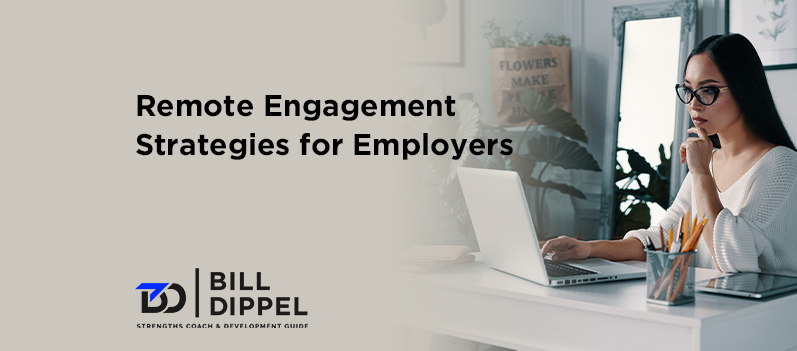Understanding Remote Engagement Strategies and Crafting an Effective Hybrid Work Policy
With the worst of the pandemic behind us, it might be tempting to try and return to business as usual. The idea is comforting — that we might be able to return to our lives just as we left them. But if you ask the workforce that’s been riding out this storm, they’ll tell you that nothing is the same for them.
According to Gallup, over 70 million employees have jobs that can be done remotely. Of those people, a staggering 90% do not want to come back to the office full-time. That’s okay, you might say, let them work from wherever they want! And while I applaud your eagerness to find a solution, that isn’t going to solve all the issues. There is a way to make the workplace work for everyone (I promise!) you just have to craft an effective hybrid work policy that fits your organization. No two workplaces are alike, and therefore, their policies should reflect that.
“Workers are expecting more flexibility in their work environment, the first big thing organizations can do to is begin crafting an effective hybrid work policy.”
 What are workers saying?
What are workers saying?
Work from home, or remote work, is incredibly common. Even before the pandemic, employees whose jobs were remote-capable were already reporting that they worked an average of 2.4 days remotely per month. Understandably, that number skyrocketed to 5.8 days in 2020. And, now that the seas have begun to calm, these workers are reporting an average of 3.8. All that is to say that workers are expecting more flexibility in their work environment.
How much flexibility seems to be the real issue at hand. When compared to one another, employees who work completely from home are, on average, less motivated than those who are in a hybrid format. Putting that much distance between the physical workplace and the employee has a detrimental effect on engagement, productivity, and a whole slate of other factors.
Additionally, we can’t forget to consider our completely in-office employees who could work from home. This group of employees is especially susceptible to burnout and apathy because many of them feel like they are missing out by being bound to their office chairs. A majority of these kinds of employees (65%) would prefer to have a hybrid option. And if those needs aren’t being met, you can be sure they’ll find somewhere else that will offer them what they’re looking for. What can organizations do?
What can organizations do?
The first big thing organizations can do to begin crafting an effective hybrid work policy is to be open to the concept. Too often, I see managers and leaders who believe that business should be conducted in the office as it always has been. This unrelenting adherence to the ways things have “always been done” is detrimental to the future of any organization looking to survive in the increasingly complicated and diverse workforce landscape. Additionally, I often see employers who bend to the will of their employees to a fault. Too much of a good thing is never good in the long run. So, what do you do?
Start with your managers
Whether they’re included in your hybrid work policy or not, they need to be in the loop in all decisions that will affect their teams. They know their people best, and making decisions without them would be like steering blind. Get them together, or talk to them separately, whatever makes sense to you, and use their skills to figure out what would be best for your organization. Craft the Policy
Craft the Policy
When you’ve got a policy for which employees can work from home, drill down on how often they can do this. I’d recommend that employees still come into the office for a portion of their time because this has been shown to increase their connection to the mission of your company. It also serves as a way to more directly assess employee work and engagement. In the policy, Gallup recommends that managers hold at least one meaningful conversation (15-30 minutes minimum) per week with employees working remotely. This is the single most effective way to keep these employees engaged and prospering. Keeping the lines of communication open will relieve any growing tension before it has a chance to develop into quiet quitting or worse.
Follow up
With any major change in an organization, follow-through is going to be key. You might not get it right the first time, and that’s okay. Being willing to change and develop is the most important thing you can do with a workforce as diverse and wildly talented as the one we have today. Your employees are your greatest resource, so make sure to listen to them and do your best to craft a hybrid work policy that engages them and keeps them productive.Closing thoughts
Stay open-minded. Hybrid work is here to stay, and it can be incredibly powerful if used well. Determining what your hybrid work policy should look for might seem daunting, but it’s absolutely possible. If you need some extra direction, I’d encourage you to reach out to us for guidance. We’ve helped numerous companies during these tumultuous times, and our experience will help you as well:
- Schedule A Call.
Set up a complimentary 15-minute call. We’ll discuss your situation and identify where you can start to form your hybrid work policy. - Get A Plan.
We’ll help you craft a hybrid work policy that will address the specific needs of your organization, - Carry It Forward.
Consider implementing a broader strengths-based philosophy in your company. We offer a wide range of services to improve on every aspect of your organization.


Recent Comments